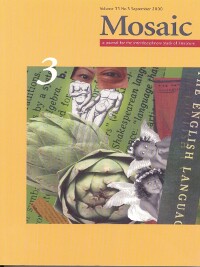Issue 33.3
Overview

General Issue
Published: September 2000
View the issue introduction or see the issue summary and contents below.
10 essays, totalling 192 pages
$15.00 CAD
This general issue of Mosaic includes essays that focus on framing narratives of power and the place of minority voices. Among these are essays examining the New York Ballet and The Nutcracker, national discourse in No-No Boy and Obasan, and race in Krazy Kat. Additional essays examine familial roles in the works of E.M. Forster and William Wordsworth.
Dancing Through the Cold War: The Case of The NutcrackerCatherine Gunther Kodat George Balanchine’s immensely popular 1954 production of The Nutcracker simultaneously created a new U.S. holiday “tradition” and ensured the financial stability of the New York City Ballet. This essay explores how the ballet’s effort to repackage a modernist aesthetic as family entertainment resulted from a complex negotiation with the cultural imperatives of the Cold War. | |
The Doubled Edge: Identity and Alterity in the Poetry of Eavan Boland and Nuala Ní DhomhnaillPaul Keen This essay situates the work of two Irish women poets, Eavan Boland and Nuala Ní Dhomhnaill, in relation to their own theoretical writings about the intersections between gender, nation, and colonial history. It reads these debates within the context of wider political and cultural shifts in Ireland today. | |
Resilient ImagiNations: No-No Boy, Obasan and the Limits of Minority DiscourseApollo O. Amoko Critical attention has recently focused on the ways in which minority discourses contest the exclusionary tendencies of nationalist consolidation. This paper draws on the theories of Homi Bhabha as well as the fiction of Joy Kogawa and John Okada to trace the license and limits of minority discourses. | |
George Herriman’s Black Sentence: The Legibility of Race in Krazy KatEyal Amiran George Herriman, who passed for white, examines the place of color, both ink and ethnic marker, in the machinery of narrative. Color is necessary to narrative, hut narrative conceals color, sentencing Herriman to perform his invisibility even as he relies on color to make this point. | |
Structure and Symbol in the Film Réquiem por un campesino españolHuw Aled Lewis Francesc Betriu’s 1985 film of Ramón J. Sender’s Réquiem un campesino espan̅ol, through use of sounds and images, oscillates between the re-creation of the original novel and reinterpretation of its view of the culpability involved in the build-up to the Spanish Civil War. | |
Fractured Bodies: Privileging the Incomplete in Jeanette Winterson’s The PassionThomas Fahy Many contemporary writers use fragmented bodies as a way of exploring the various coercive forces that tear people apart and fracture their relationships with others. In The Passion Jeanette Winterson uses bodies to offer a solution to postmodernist narratives of fragmentation, enabling her characters to find meaning in art that validates the incomplete. | |
Antinomies of Double Consciousness in Aimé Césaire’s Cahier d’un retour au pays natalNick Nesbitt Against the monological tenor of much postcolonial criticism, this essay argues for, and finds ethical value in, the inherent double character of Aimé Césaire’s Cahier d’un retour au pays natal. The poem describes an Afro-Caribbean “double consciousness,” allowing Césaire to dramatize the antinomical character of freedom postulated amidst social inequity. | |
A Passage to Italy: Narrating the Family in Crisis in E. M. Forster’s Where Angels Fear to TreadKenneth Womack Critics consistently neglect to consider the crucial place of the family in E.M. Forster’s novel Where Angels Fear to Tread. Using the terminology of family systems psychotherapy, this essay illuminates Forster’s illustrations of class, culture, and ethics in the text. | |
Wordsworth, Revision, and the Blessed Babe: Reading the Mother in Book 2 of The PreludeRobert C. Hale Intersubjective theory suggests that in early versions of The Prelude, Wordsworth views poetic power as predicated on the child’s relationship with the mother. But in his revisions Wordsworth objectifies the mother, hesitates to associate poetic power with her, and emphasizes the child’s relationship with personified Nature. | |
The Religious Initiation of the Reader in D. H. Lawrence’s The RainbowCharles M. Burack Some of the most influential modern British writers sought to evoke numinous states of consciousness in their readers. Using a phenomenological approach to the reading experience, this essay argues that D. H. Lawrence structures his novel The Rainbow as a religious initiation rite for revitalizing and reintegrating the reader’s consciousness. |